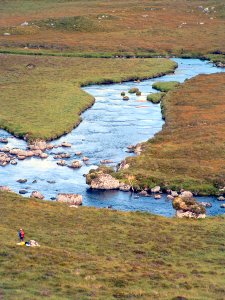Substrate stability: safe places to hide

Stable salmon spawning area in Little Gruinard River
For juvenile salmon, the most productive areas tend to be those where the streambed is stable with plenty of voids in which fish can hide and where water remains clear and flows relatively evenly; with nearby 'spawning' habitat of loose, clean pebble-sized sediment in which adult fish can easily spawn and in which the survival of eggs to hatch is high. Such areas are found in many of the river systems below lochs, where glacial deposits have been winnowed away and gently reworked by water (and spawning fish).
At the other end of the in-stream habitat continuum for salmon are riverine areas where there is much movement of sediment and scouring. Unstable spawning areas are vulnerable to redd washout with low rates of survival of eggs. Exceptionally, summer spates may wash out fry and salmon parr, and reduce invertebrate populations.
Much of the variation in habitat stability and the amount of cover is entirely natural, the product of geology, gradient and rainfall. However, the rates at which stream banks erode are influenced by catchment management practices. Where riparian vegetation is weakened by heavy grazing pressure and riparian trees are dying back, rates of erosion and sediment input increase. Past and predicted trends in rainfall intensity are likely to exacerbate the level of habitat instability of some headwater streams.
Gallery
Click a photograph to see it enlarged.
Related Downloads
To download a file, right-click over it's name and choose Save Link/Target As...
-
Little Loch Broom BRUV Surveys 2022
Presentation by Dr Neil Hopkins and Dr Charlotte Hopkins describing animal movements in relation to seascapes and underwater habitats from baited underwater remote video survey of Gruinard Bay and Little Loch Broom in 2022, shown at Wester Ross MPA Discovery Day on 14th October 2022. Screenshots have been taken from video clips presented to illustrate animal diversity recorded. . Posted: 08/11/2022 (1.47MB) -
Maerl by Prof Jason Hall-Spencer
Maerl supports the whole web of life with 100s of species using it for spawning, nursery areas, hiding and feeding. This presentation by Prof Jason Hall-Spencer at Wester Ross MPA Discovery Day on 14th October explains why it is so important to protect maerl habitats. . Posted: 27/10/2022 (1.92MB) -
WRFT Newsletter March 2022
This newsletter provides a summary of some of the work of WRFT over 2021, including some plans for 2022. Posted: 11/03/2022 (2.95MB) -
Little Gruinard FMP April 2011 Part 7 & 8
Little Gruinard River FMP April 2011 Part 7 & 8. Posted: 03/02/2011 (8.92MB) -
Presentation by John Roberston (FWAG) on SRDP funding
Presentation by John Roberston (FWAG) on SRDP funding given at workshop on 26th January 2009. Click on the links in this presentation to explore related pages on the SRDP website. Posted: 04/02/2009 (457KB) -
Little Gruinard juvenile fish assessment 2006 report
This illustrated report presents the results of the 2006 WRFT Little Gruinard electro-fishing survey. Relationships between juvenile salmon abundance and habitat characteristics are discussed. The natural production of juvenile salmon in this Special Area of Conservation (SAC) for Atlantic salmon could be strengthened through restoring levels of natural fertility within the Little Gruinard catchment area. Posted: 22/09/2008 (964KB)
![Little Gruinard River is prime habitat for juvenile [click to enlarge] Little Gruinard River is prime habitat for juvenile [click to enlarge]](/images/habitats/t_fishinglittlegruinard.jpg)
![Unstable habitat in the River Carron [click to enlarge] Unstable habitat in the River Carron [click to enlarge]](/images/habitats/t_carron.jpg)
![Unstable habitat in the Ullapool River headwaters [click to enlarge] Unstable habitat in the Ullapool River headwaters [click to enlarge]](/images/habitats/t_unstablehabitat.jpg)